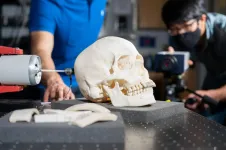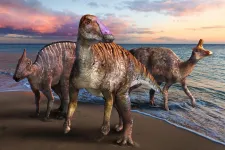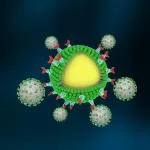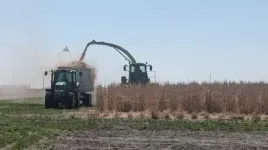Canola growth environments and genetics shape their seed microbiomes
2021-04-27
(Press-News.org) Just as humans receive the first members of their microbiomes from their mothers, seeds may harbor some of the first microorganisms plants encounter. While these initial microbes could become influential players in the plants' microbiomes, the microbial communities that colonize seeds have not received as much attention as root, shoot, or soil microbiomes. To understand how seed microbiomes are assembled, a group of researchers at the University of Saskatchewan (Canada) examined the relative effects of growth environment and plant genotype on the seed microbiome of canola, a globally important crop grown in diverse environments.
In their recently published paper in Phytobiomes Journal, Zayda Morales Moreira, Bobbi Helgason, and James Germida characterized the seed microbiomes of eight canola lines harvested in different years and from different sites in Saskatchewan that are representative of local canola growing regions. They found that seed microbiomes differed not only by harvest year and location, but also by the variety of canola, indicating that both genetic and environmental factors play important roles in seed microbiome assembly. These findings suggest that both plant breeding and seed production conditions could be used to shape beneficial seed microbiomes. Lead author Zayda Morales Moreira believes "increasing our knowledge of how microbial communities carried by seeds are assembled, transmitted, and preserved offers a promising way for breeding programs to consider microbial communities when selecting for more resilient and productive cultivars."
This paper lays the groundwork for future research into the seed microbiome, such as examining how these differently assembled communities of microbes affect plant growth and resilience. Their results also suggest the presence of a core microbiome in all seed samples that includes potentially beneficial microbes such as Pseudomonas spp., which are known to promote plant growth. If seed-derived microbes improve seedling survival or become key components of the microbiome throughout the plants' life cycles, optimizing seed microbiomes--through breeding or seed inoculants--could be an important tool for managing plant microbiomes in agriculture. The authors hope that understanding the seed microbiome will advance current sustainable agricultural practices and breeding techniques.
INFORMATION:
To find out more, read the original article " END
[Attachments] See images for this press release:

ELSE PRESS RELEASES FROM THIS DATE:
2021-04-27
It's easy to think that more nutrients -- the stuff life needs to grow and thrive -- would foster more vibrant ecosystems. Yet nutrient pollution has in fact wrought havoc on marine systems, contributing to harmful algae blooms, worse water quality and oxygen-poor dead zones.
A team of researchers from UC Santa Barbara has proposed a novel strategy for reducing large amounts of nutrients -- specifically nitrogen and phosphorous -- after they have already been released into the environment. In a study appearing in the journal Marine Policy, the authors contend that seaweed's incredible ability to draw nutrients from the water could provide an efficient and cost-effective solution. Looking at the U.S. Gulf of Mexico, the team identified over 63,000 square kilometers suitable for seaweed aquaculture.
"A ...
2021-04-27
The discovery of a novel enzyme that releases a valuable chemical from agricultural waste could provide an important breakthrough in the upscaling of renewable fuels and chemicals, a new study shows.
Researchers - led by the University of York - have discovered an enzyme in a fungus which can act as a catalyst to bring about a biochemical reaction that breaks down lignocellulose
Lignocellulose is found in forestry and agricultural waste like wheat straw, which was used in this research. It has long been considered by scientists that this dry matter could ...
2021-04-27
A team of engineering researchers at the Georgia Institute of Technology hopes to uncover new ways to diagnose and treat brain ailments, from tumors and stroke to Parkinson's disease, leveraging vibrations and ultrasound waves.
The five-year, $2 million National Science Foundation (NSF) project initiated in 2019 already has resulted in several published journal articles that offer promising new methods to focus ultrasound waves through the skull, which could lead to broader use of ultrasound imaging -- considered safer and less expensive than magnetic resonance imaging (MRI) technology.
Specifically, the team is researching a broad range of frequencies, spanning low frequency vibrations (audio frequency range) and moderate frequency guided waves (100 kHz to 1 MHz) to high ...
2021-04-27
DALLAS (SMU) - An international team of paleontologists has identified a new genus and species of hadrosaur or duck-billed dinosaur, Yamatosaurus izanagii, on one of Japan's southern islands.
The fossilized discovery yields new information about hadrosaur migration, suggesting that the herbivors migrated from Asia to North America instead of vice versa. The discovery also illustrates an evolutionary step as the giant creatures evolved from walking upright to walking on all fours. Most of all, the discovery provides new information and asks new questions about dinosaurs in Japan.
The research, "A New Basal Hadrosaurid (Dinosauria: Ornithischia) From the latest Cretaceous Kita-ama Formation in Japan implies the origin of Hadrosaurids," ...
2021-04-27
Researchers at the Pritzker School of Molecular Engineering (PME) at the University of Chicago have designed a completely novel potential treatment for COVID-19: nanoparticles that capture SARS-CoV-2 viruses within the body and then use the body's own immune system to destroy it.
These "Nanotraps" attract the virus by mimicking the target cells the virus infects. When the virus binds to the Nanotraps, the traps then sequester the virus from other cells and target it for destruction by the immune system.
In theory, these Nanotraps could also be used on variants of the virus, leading to a potential new way to inhibit the virus going forward. Though the therapy remains in early stages of testing, the researchers envision it could be administered ...
2021-04-27
In a paper published in the journal Scientific Reports, researchers from Surrey investigated whether the daily consumption of a prebiotic food supplement could improve overall wellbeing in a group of 18 to 25 year-olds. The study found that those who received a daily dose of prebiotics improved mental wellbeing by reducing anxiety levels and had better gut health than the control group.
Researchers studied a group of 64 healthy female participants with no current or previous clinical diagnoses of anxiety. Participants received either a daily dose of the prebiotic galacto-oligosaccharides (GOS) or a placebo for 28 days.
All those involved in the trial completed surveys about their health experiences, including mood, anxiety and sleep quality and provided a stool sample ...
2021-04-27
New studies from the Center for Advanced Bioenergy and Bioproducts Innovation (CABBI) shed more light on the economic and environmental costs of mandates in the Renewable Fuels Standard (RFS), a federal program to expand the nation's biofuels sector.
Researchers said the studies indicate the need to adopt more targeted policies that value the environmental and ecosystem benefits of perennial bioenergy crops over cheaper options -- and provide financial incentives for farmers to grow them.
The RFS was issued in 2005 and updated through the Energy Independence and Security Act of 2007 ...
2021-04-27
MEMPHIS, Tenn. - For the first time in published literature, Le Bonheur Children's Hospital and University of Tennessee Health Science Center (UTHSC) researchers showed that a variety of white blood cells known as eosinophils modify the respiratory barrier during influenza A (IAV) infection, according to a recent paper in the journal Cells. This research could have implications in understanding SARS-CoV-2 (COVID-19) infection in asthmatic patients.
The Le Bonheur/UTHSC study found that eosinophils immunomodulate airway epithelial cells during IAV infection, helping to neutralize the virus and ...
2021-04-27
The legend of the "kraken" has captivated humans for millennia. Stories of deep-sea squid dragging sailors and even entire ships to their doom can be found in everything from ancient Greek mythology to modern-day movie blockbusters. It is therefore ironic that the species that inspired these stories, the giant squid Architeuthis dux, is camera-shy. In fact, filming this species in the wild has proven an insurmountable challenge for countless scientists, explorers, and filmmakers. To date, only one scientist, Dr. Edith Widder of the Ocean Research & Conservation Association, has repeatedly caught a live giant squid on camera. In a new study, Dr. Widder and her colleagues have finally revealed the secrets behind their success. This study, which is free to access, also ...
2021-04-27
An Academic Analytics Research Center (AARC) study published in the journal Scientometrics found that senior faculty (scholars who earned their terminal degree 30 or more years ago) research publication activity exceeded expectations based on age cohort population for book chapters and book publications, and senior scholars largely kept pace in terms of journal article publications. "Across all disciplines, senior faculty may be uniquely positioned to invest their time in a longer-term publication effort, shifting their research focus to the review and synthesis of ideas through the publication of books and chapters," said AARC Senior Researcher and Co-Author of the study, Bill Savage, Ph.D.
The study explored the publishing activity of 167,299 unique faculty members at American ...
LAST 30 PRESS RELEASES:
[Press-News.org] Canola growth environments and genetics shape their seed microbiomes




